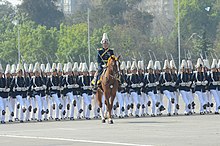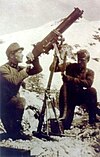Steyr Model 1912 Mauser
| Repetiergewehr M.14 | |
|---|---|
 An Austro-Hungarian M.14 | |
| Type | Bolt-action rifle |
| Place of origin | German Empire/Austria-Hungary |
| Service history | |
| In service | 1912-Present[citation needed] |
| Used by | See Users |
| Wars | |
| Production history | |
| Designed | 1912 |
| Manufacturer | Steyr |
| Specifications | |
| Mass | 3.97 kilograms (8.8 lb)-4.11 kilograms (9.1 lb) |
| Length | 1,245 millimetres (49.0 in)-1,247 millimetres (49.1 in) |
| Barrel length | 736 millimetres (29.0 in)-740 millimetres (29 in) |
| Cartridge | 7×57mm Mauser |
| Action | Bolt-action |
| Feed system | 5-round stripper clip, internal magazine |
| Sights | Iron sights adjustable to 1,800 metres (2,000 yd) |
The Steyr Model 1912 were Gewehr 98 pattern bolt-action battle rifles produced by Steyr before World War I. They were designed for export market. During the war, they were also used by the Austro-Hungarian Army.
Design
The rifle was a close copy of the Gewehr 98. It had a pistol grip stock. The rifle featured a "H"-type bayonet lug.[1] The sight was tangent-leaf, graduated to 1,800 metres (2,000 yd) or 2,000 metres (2,200 yd).[2][3] The upper hand guard was shorter.[4]
The carbine and short rifle versions had a turned-town bolt handle and were shorter,[3] with sights graduated until 1,400 metres (1,500 yd).[2]
The version pressed into Austrian service in 1914 was only modified by using a bigger sling swivel.[5]
Service

It was ordered by Mexico,[3] Colombia,[4] Chile,[6] China,[7] Mexican Model 1912 were used from 1913 by the Federal Army that fought during the Mexican Revolution.[8] In 1914, 66,979 Mexican-contract rifles, 5,000 Colombian rifles and 43,100 Chilean rifles and carbines were pressed into Austria-Hungarian service as Repetiergewehr M.14.[5]
The Czech vz. 98/22 was a close-copy of the Steyr M1912 and the vz. 12/33 carbine derives from the M1912 carbine.[9] Some of the non-delivered Mexican Model 1912 rifles were modernized as 7.92×57mm Mauser Model 24B in Yugoslavia.[10] In 1929, 5,000 M1912 short rifles, with a 560 millimetres (22 in) barrel, were manufactured by Československá zbrojovka Brno from Steyr spare parts.[11] In 1961, Chilean M1912 were upgraded with a 7.62×51mm NATO 600 millimetres (24 in) barrel, as Modelo 12/61.[12]
Users

 Afghanistan[13]
Afghanistan[13] Albania[14]
Albania[14] Algeria[15]
Algeria[15] Angola[16]
Angola[16] Austria-Hungary: Repetiergewehr M.14 [5]
Austria-Hungary: Repetiergewehr M.14 [5] Bangladesh[citation needed]
Bangladesh[citation needed] Benin
Benin Bolivia[17]
Bolivia[17] Bosnia and Herzegovina[18]
Bosnia and Herzegovina[18] Botswana
Botswana Burkina Faso[19]
Burkina Faso[19] Burundi[citation needed]
Burundi[citation needed] Canada[20]
Canada[20] Cape Verde[citation needed]
Cape Verde[citation needed] Chad
Chad Chile: Modelo 1912 and Model 12/61[6]
Chile: Modelo 1912 and Model 12/61[6] China[21]
China[21] Republic of China (1912-1949): ?[7]
Republic of China (1912-1949): ?[7] Colombia: Modelo 1912[4]
Colombia: Modelo 1912[4] Cyprus[17]
Cyprus[17] Democratic Republic of Congo[22]
Democratic Republic of Congo[22] Djibouti
Djibouti Dominican Republic[18]
Dominican Republic[18] Egypt
Egypt Eritrea[citation needed]
Eritrea[citation needed] Estonia
Estonia Fiji
Fiji Gabon[23]
Gabon[23] Ghana
Ghana Guatemala
Guatemala Japan[24]
Japan[24] Jordan
Jordan Macedonia[25]
Macedonia[25] Madagascar
Madagascar Malta[25]
Malta[25] Mexico: Modelo 1912[10]
Mexico: Modelo 1912[10] Morocco
Morocco Mozambique[26]
Mozambique[26] Myanmar
Myanmar Namibia
Namibia Nepal
Nepal North Korea[27]
North Korea[27] Oman
Oman Pakistan[17]
Pakistan[17] Panama[18]
Panama[18] Qatar[citation needed]
Qatar[citation needed] Seychelles
Seychelles Sierra Leone[17]
Sierra Leone[17] Singapore[18]
Singapore[18] Slovenia
Slovenia Somalia[25]
Somalia[25] South Africa[28]
South Africa[28] South Korea[29]
South Korea[29] Sri Lanka[25]
Sri Lanka[25] Sudan
Sudan Suriname[citation needed]
Suriname[citation needed] Switzerland[30]
Switzerland[30] Thailand[15]
Thailand[15] Togo
Togo Uganda
Uganda Ukraine
Ukraine United Kingdom[31]
United Kingdom[31] United States[32]
United States[32] Kingdom of Yugoslavia: M24B[10]
Kingdom of Yugoslavia: M24B[10] Zimbabwe
Zimbabwe
References
- ^ Ball 2011, p. 258.
- ^ a b Ball 2011, p. 79.
- ^ a b c Ball 2011, p. 261.
- ^ a b c Ball 2011, pp. 101–102.
- ^ a b c Ball 2011, p. 20.
- ^ a b Ball 2011, p. 76.
- ^ a b Ball 2011, p. 86.
- ^ de Quesada, Alejandro; Jowett, Philip (28 Feb 2006). The Mexican Revolution 1910–20. Elite 137. Osprey Publishing. p. 14. ISBN 9781841769899.
- ^ Ball 2011, p. 112.
- ^ a b c Ball 2011, p. 161.
- ^ Ball 2011, p. 123.
- ^ Ball 2011, p. 77.
- ^ Cite error: The named reference
Afghanwas invoked but never defined (see the help page). - ^ "Le Carcano modèle 1891 et ses dérivés". La Gazette des Armes (in French). No. 239. December 1993. pp. 25–29.
- ^ a b Cite error: The named reference
Arnold2020was invoked but never defined (see the help page). - ^ Cite error: The named reference
weaponwas invoked but never defined (see the help page). - ^ a b c d Walter, John. Rifles of the World. Krause Publications. p. 273. ISBN 0-89689-241-7.
- ^ a b c d Smith, Joseph E. (1969). Small Arms of the World (11 ed.). Harrisburg, Pennsylvania: The Stackpole Company. p. 719.
- ^ Cite error: The named reference
Tinderboxwas invoked but never defined (see the help page). - ^ Cite error: The named reference
Canadianwas invoked but never defined (see the help page). - ^ Cite error: The named reference
PRCwas invoked but never defined (see the help page). - ^ Cite error: The named reference
Congowas invoked but never defined (see the help page). - ^ Cite error: The named reference
bishop2020was invoked but never defined (see the help page). - ^ Cite error: The named reference
IJAwas invoked but never defined (see the help page). - ^ a b c d McLachlan, Sean (20 Sep 2011). Armies of the Adowa Campaign 1896: The Italian Disaster in Ethiopia. Men-at-Arms 471. Osprey Publishing. pp. 35–36. ISBN 9781849084574.
- ^ Capie, David (2004). Under the Gun: The Small Arms Challenge in the Pacific. Wellington: Victoria University Press. pp. 66–67. ISBN 978-0864734532.
- ^ Cite error: The named reference
DPRKwas invoked but never defined (see the help page). - ^ Cite error: The named reference
SARwas invoked but never defined (see the help page). - ^ Cite error: The named reference
ROKwas invoked but never defined (see the help page). - ^ Cite error: The named reference
Swisswas invoked but never defined (see the help page). - ^ Cite error: The named reference
UKwas invoked but never defined (see the help page). - ^ "Steyr AUG/A3 SA USA". Steyr Mannlicher US. Steyr Mannlicher. Retrieved 4 June 2009.
- Ball, Robert W. D. (2011). Mauser Military Rifles of the World. Iola: Gun Digest Books. ISBN 9781440228926.
{{cite book}}: Invalid|ref=harv(help)

